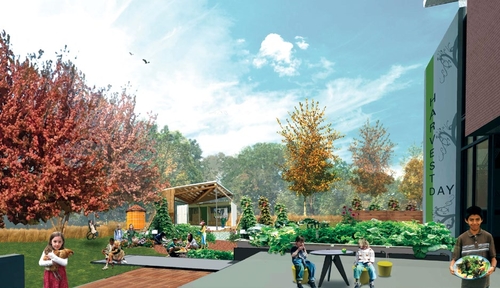Since kids spend much of their day at school, obesity experts think school design can impact student health.
A UNMC obesity expert is the main author of a report — Healthy Eating Design Guidelines for School Architecture — that appeared in the March issue of the journal, Preventing Chronic Disease published by the Centers for Disease Control and Prevention (CDC).
Merging architecture with public health, the report details how cafeterias, water fountains, gardens and signage play a key role in establishing a healthy environment.
“We know there is a direct link between student performance and student health,” said Terry Huang, Ph.D., chairman and professor of health promotion, social and behavioral health in the UNMC College of Public Health. “What we want to do is develop evidence-based principles of school design that optimize healthy eating and health practices.”
The guidelines were incorporated into the Buckingham County Primary and Elementary School in a rural, ethnically diverse school in central Virginia. The school district embraced the goal of creating an optimized ‘healthy eating’ learning environment in addition to the goal of creating an energy-efficient building.
Some of the design principles incorporated include:
- A food lab where kids can learn how to prepare healthy foods;
- A cafeteria that facilitates fresh food production;
- A school garden for kids to grow food for the school cafeteria and burn a few calories;
- A lower-stress environment to address light, noise levels, air quality and crowding; and
- Layouts that encourage more movement and the use of attractive water fountains in every classroom and throughout the school.
“Our goal is to provide fresh, healthy food choices and support school spaces which promote healthy nutrition and healthy habits,” Dr. Huang said.
Researchers add that even simple changes like providing healthy grab-and-go meal options, avoiding deep-fat fryers and a library of health information and nutrition are improvements that schools can use to promote optimal health.
Obesity now affects 17 percent of all children and adolescents in the United States — triple the rate from just one generation ago, according to the CDC.
Dr. Huang and his collaborators hope these guidelines will become part of a national strategy to prevent and reduce childhood obesity.
He has developed innovative ways to combine environmental and individual strategies to shift culture toward better health.
During the past six years, Dr. Huang has spearheaded a national “systems approach” to childhood obesity prevention. Based on this “systems approach,” he is interested in how individuals interact with their environment to create change in norms and behaviors around diet, physical activity and obesity.
He also led an effort in the South Omaha community that incorporates youth advocacy, community development, social marketing and social media to increase the community’s capacity to address obesity and diabetes.
One of the most significant health risks today, obesity contributes significantly to the economic cost of health care, Dr. Huang said.
“Most of us know how difficult it is to lose weight once we gain the pounds. Preventing obesity from starting in childhood is key to a healthier population. My work at the policy level also has led to significant shifts in the way researchers and policymakers think about obesity prevention and has helped expand the theoretical foundations of public health in general.”
In May, Dr. Huang was recognized as one of UNMC’s Distinguished Scientists for 2012. Last year, Dr. Huang and his graduate assistant, Leah Frerichs, along with Matthew Trowbridge, M.D., at the University of Virginia and VMDO Architects received the Design Research and Scholarship prize at the Virginia Society of the American Institutes of Architects annual meeting in Richmond. The group also was recognized as one of the winners in the Childhood Obesity Challenge from the American Journal of Preventive Medicine/ Robert Wood Johnson Foundation.
“If we can get children to learn to naturally choose healthier foods, drink water and move around more at school, we hope those habits will continue at home. As we found in the South Omaha project, the kids became instruments of change in the family.”
